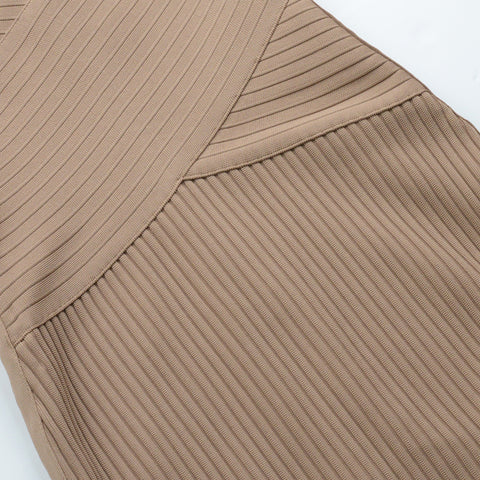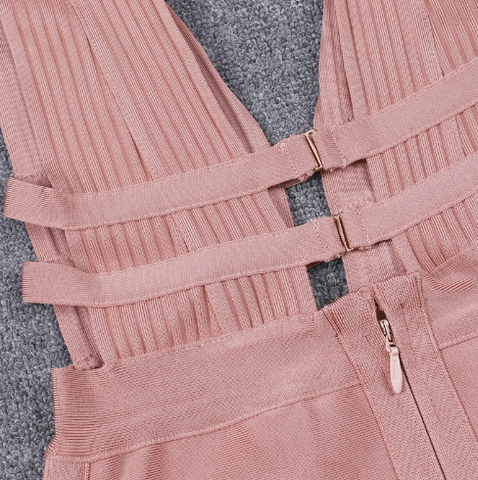Caring For Your Fabric
Fabric is precious. We've put together a few guidelines to help you care for your new purchase. It's a good idea to pre-wash any washable
natural fibres that you will be washing in the future, as some shrinkage may occur.
We recommend pre-washing in the same way you intend to wash your future fabric creation including drying.
Wash light and bright colours separately, as some colours may run in their first few washes. Please note, these care tips are guidelines
only and variations will apply to some fabrics. If you have any questions, please do not hesitate to contact us.


Bandage
High-quality bandage dress material consists of a blend of spandex, nylon, and rayon. They cling almost like a second skin and stretch to shape and highlight your curves.
Washing
-
Dry cleaning– If you don’t want to risk washing your dress at home then dry cleaning is for you. This method takes the
cleaning out of your hands although it can be pricey.
• Washing Machine – Machine washing can be risky. However, if you want to give it a go then just choose the coolest and gentlest cycle. Most washing machines do have a hand-washing cycle which would be a great choice.
• Hand Wash – The best place to hand wash your dress is in the bath tub. This way the dress can be placed flat during the wash which will help keep the shape and elasticity. Use soapy water and dunk the dress under the water a few times. Unplug the water and give the dress a rinse. Never wring the dress out or squeeze it! Just gently push the excess water out.
• Quick Clean – If you just have a little stain then dampen the area with cold water and gently rub in a little soap. Rinse off and pat dry.
Drying
That’s the washing taken care of now we will discuss drying. Drying the dress is simple. All you have to do is place the dress flat on a clothes rack or on a towel. Leave it to dry and just give it a turn occasionally. Never hang the dress on a hanger while drying! This will put the dress out of shape and effect the elasticity.
Ironing
You should iron the dress while it is still damp. Keep your iron on a low heat and iron the dress inside out so you don’t get iron marks. If you need to iron the dress dry then simply put a damp cloth in-between the dress and the iron.
Storage
Now you dress is clean and ironed, how should you store it? For dresses with sleeves and straps hang the dress up on a hanger. Avoid wire hangers. If you can’t hang the dress due to a sleeveless style or space in the closet then try and lay it flat in a draw. If you must, fold the dress, but don’t fold it too much. Otherwise you will get creases and your ironing will have gone to waste! So, keep it hung or stored flat with plenty of space.
Sequin
An embellishment, either plastic or metal, that is applied to a material such as cotton, silk, wool, or a synthetic. Commonly found on dresses, skirts, and blouses.
Washing
Dry cleaning
Adorned garments often need to be cleaned at a specialist dry cleaner, which is expensive.
• Use a reputable dry cleaner that specialises in caring for evening gowns and wedding dresses.
• If possible, provide the dry cleaner with off-cuts of the adorned fabric to test before cleaning the garment.
• Make sure the dry cleaner uses the ‘F’ (hydrocarbon solvent) cleaning method or Green Earth dry cleaning method.
• If the garment has metal decorations, you can ask the dry cleaner to ‘foil’ the decorations so they won't crack or tarnish during cleaning
or ask for the garment to be hand-cleaned. Some cleaners will remove the decorations before cleaning a garment and then reattach them.
Hand washing
If the garment can be hand washed:
• Do up all zips, buttons etc and turn it inside out.
• Fill a clean bowl/sink with hand-warm (maximum of 30°C) water and put in the correct amount of washing detergent. Ensure you use a gentle
detergent that is designed for delicate fabrics.
• Place the garment into the water and wash using a gentle plunging/swishing action. Avoid rubbing the garment as too much agitation can
bend or break the beads/sequins.
• Rinse the garment in several rinses of cool water – until the rinsing water is clear.
• Gently squeeze the water out (do not wring).
Machine washing beaded/sequined garments
If the garment can be machine washed:
• Do up all zips, buttons etc and turn the garment inside out.
• Put the garment in a mesh laundry bag or pillow case before putting it in the machine.
• Wash the garment on its own (in case the dye runs) on a very gentle wash cycle at a maximum of 30°C using a detergent that is suitable for
washing delicate fabrics.
• Set the spin cycle on the lowest speed to prevent damage.
• Check for embellishments that may have fallen off during washing.
Drying
-
Lay the inside out garment onto a clean, dry and lint free towel, then roll it up and gently squeeze to remove excess water. Repeat this
using another dry towel if necessary.
• Gently turn the garment right side out and air dry it on a flat surface.
• Never put beaded/sequined garments in a tumble dryer as the sequins could melt and the action of the drum can cause damage.
Ironing
Garments that are decorated with beads and sequins should not be ironed. To remove creases, either:
• Turn the garment inside out and use a clothes steamer (only for fabrics that can be washed). Keep the steam wand 30cm away from the
fabric; or
• Hang the garment in a steamy bathroom.
• Always allow the garment to dry completely before wearing to avoid creating more creases.
Repair
If you see a loose bead/sequin or thread, do a few securing stitches to hold the beads/sequins in place as soon as you can. If a lot of beads or sequins have come off, it is best to have the garment repaired by a specialist.
Storage
-
Make sure the garment is clean and aired before you put it away.
• Hang embellished garments on strong padded non-slip hangers, ensuring that you use the garment hanging loops to help support the weight. Ensure the garments are not crushed in the wardrobe and use a garment cover to help keep the garment clean.
• Alternatively, if the garment is very heavy, wrap the garment in acid free tissue paper, carefully fold and store flat.
Satin
Fabric woven with floating yarns made of silk, rayon, acetate, nylon, polyester, or a blend. Known for its luxurious, smooth, lustrous, and draping qualities.
Washing
-
Handwashing is always the best and safest method for washing satin.
• Add 2 capfuls or a squirt of Delicate Wash to a washbasin or sink filled with cool water.
• Submerge the item and gently agitate the water with your hands to evenly distribute soap. Soak for up to 30 minutes.
• Rinse well by running cool water through the item until the water is no longer soapy.
• Do not wring. Instead, press the water out of the item.
Drying
Air drying is the best option for satin fabrics. Satin should never be wrung out to remove excess water. Get the excess water out by laying the item flat on a dry towel and rolling the towel up with the satin item inside. Apply gentle pressure to the towel to force out the excess water. Unroll the towel and remove the item. Lay the satin item on a dry towel and let it air dry.
Ironing
It takes special care to iron satin. Use a warm iron and absolutely no steam. Always press satin on the wrong side of the fabric and keep a pressing cloth between the iron and the fabric. A thin piece of white cotton such as a handkerchief works well as a pressing cloth. Applying a hot iron directly to satin fabric can leave behind an impression of the iron's plate and can damage the fabric.
Storage
-
Satin items such as a skirt or dress can be hung on a hanger; however, be mindful of clips because they can leave marks on the material.
• Always store items clean.
• We recommend storing in a breathable cotton hanging storage bag to protect items from bugs.
• Storing in plastic encourages yellowing and can trap mildew-causing moisture, a prime environment for bugs.
• All techniques are based on textile science. Not all garments perform and react as science would predict.
Polyester
You can wash your polyester clothes and washing polyester is simple. To do it at home, only a few key polyester washing instructions are required. In fact, polyester's properties make it one of the easiest fabrics to wash because you can actually machine wash polyester. Polyester is a synthetic fiber, so to ensure it does not break down from heat, opt for cool or warm water when washing.
Washing
Polyester can be washed in the washing machine. Machine wash items like polyester jackets with Signature Detergent on the normal cycle with warm or cool water. Wash with like colors and fabrics only. For a boost of whiteness and brightness, we recommend adding a capful of All-Purpose Bleach Alternative to each load in the wash cycle.
Drying
-
Air dry polyester or tumble dry at medium temperature. Polyester can go in the dryer, but only at a medium temperature.
• Polyester generally doesn't wrinkle. Iron as needed at a low temperature setting, or steam when drying polyester garments.
• To freshen between laundering, spritz with Fabric Fresh Classic.
Ironing
One of the most significant selling points of polyester clothing is its non-wrinkling qualities. However, if it does become heavily wrinkled or creased, the material can be tough to smooth. The best way to release creases is by ironing with steam on a medium heat setting. If that doesn't work, try using a clothing steamer.
Storage
Polyester clothes can be hung or stacked flat. If you fold polyester clothes, they tend to wrinkle. Polyester garments can be safely stored in a plastic tub or hung in a garment bag to protect them from dust for long-term storage. Freshly laundered items should be stored when thoroughly dry. Fold loosely knitted polyester pieces, and place them in drawers. Woven items and tightly knit items, such as shirts, dresses, or pants, can be hung.
